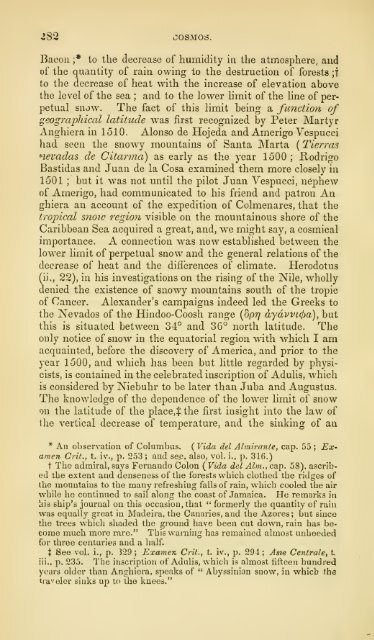See the complete document here
See the complete document here
See the complete document here
Create successful ePaper yourself
Turn your PDF publications into a flip-book with our unique Google optimized e-Paper software.
^82 COSMOS.<br />
Bacon ;* to <strong>the</strong> decrease of humidity in <strong>the</strong> atmosp<strong>here</strong>, and<br />
of <strong>the</strong> quantity of rain owing to <strong>the</strong> destruction of forests ;f<br />
to <strong>the</strong> decrease of heat with <strong>the</strong> increase of elevation above<br />
<strong>the</strong> level of <strong>the</strong> sea and to <strong>the</strong> lower ;<br />
limit of <strong>the</strong> line of perpetual<br />
snow. The fact of this limit being a function of<br />
geographical latitude was first recognized by Peter Martyr<br />
Anghiera in 1510. Alonso de Hojeda and Amerigo Vespucci<br />
had seen <strong>the</strong> snowy mountains of Santa Marta Tierras<br />
(<br />
"levadas de Citarma) as early as <strong>the</strong> year 1500 ; Rodrigo<br />
Bastidas and Juan de la Cosa examined <strong>the</strong>m more closely in<br />
1501 : but it was not until <strong>the</strong> pilot Juan Vespucci, nephew<br />
of Amerigo, had communicated to his friend and patron An<br />
ghiera an account of <strong>the</strong> expedition of Colmenares, that <strong>the</strong><br />
trojjical snow regioji visible on <strong>the</strong> mountainous shore of <strong>the</strong><br />
Caribbean Sea acquired a great, and, we might say, a cosmical<br />
importance. A connection was now established between <strong>the</strong><br />
lower limit of perpetual snow and <strong>the</strong> general relations of <strong>the</strong><br />
decrease of heat and <strong>the</strong> differences of climate. Herodotus<br />
(ii., 22), in his investigations on <strong>the</strong> rising of <strong>the</strong> Nile, wholly<br />
denied <strong>the</strong> existence of snowy mountains south of <strong>the</strong> tropic<br />
of Cancer. Alexander's campaigns indeed led <strong>the</strong> Greeks to<br />
<strong>the</strong> Nevados of <strong>the</strong> Hindoo-Coosh range {ppr] dydvvKpa), but<br />
this is situated between 34° and 36° north latitude. The<br />
only notice of snow in <strong>the</strong> equatorial region with which I am<br />
acquainted, before <strong>the</strong> discovery of America, and prior to <strong>the</strong><br />
year 1500, and which has been but little regarded by physicists,<br />
is contained in <strong>the</strong> celebrated inscription of Adulis, which<br />
is considered by Niebuhr to be later than Juba and Augustus.<br />
The knov/ledge of <strong>the</strong> dependence of <strong>the</strong> low'er limit of snow<br />
on <strong>the</strong> latitude of <strong>the</strong> place, $ <strong>the</strong> first insight into <strong>the</strong> law of<br />
<strong>the</strong> vertical decrease of temperature, and <strong>the</strong> sinking of an<br />
* An observation of Columbus. (Vida del Almirante, cap. 55 ; Ex-<br />
amen Crit., t. iv., p. 253 ; and see, also, vol. i., p. 316.)<br />
t The admiral, says Fernando Colon (^Vida del Abn., cap. 58), ascribed<br />
<strong>the</strong> extent and denseness of <strong>the</strong> forests which clo<strong>the</strong>d <strong>the</strong> ridges of<br />
<strong>the</strong> mountains to <strong>the</strong> many refreshing falls of rain, which cooled <strong>the</strong> air<br />
while he continued to sail along <strong>the</strong> coast of Jamaica. He remarks in<br />
his ship's journal on this occasion, that " formerly <strong>the</strong> quantity of rain<br />
was equally great in Madeira, <strong>the</strong> Canaries, and <strong>the</strong> Azores; but since<br />
<strong>the</strong> trees which shaded <strong>the</strong> ground have been cut down, rain has become<br />
much more rare." This warning has remained almost unheeded<br />
for three centuries and a half.<br />
t <strong>See</strong> vol. i., p. 329 ; E.xamen Crit., t. iv., p. 294 ; Aste Centrale, t<br />
iii.. p. 235. The inscription of Adulis, which is almost fifteen hundred<br />
years older than Anghiera, speaks of " Abyssinian snow, in which <strong>the</strong><br />
traveler sinks up to <strong>the</strong> knees."
















